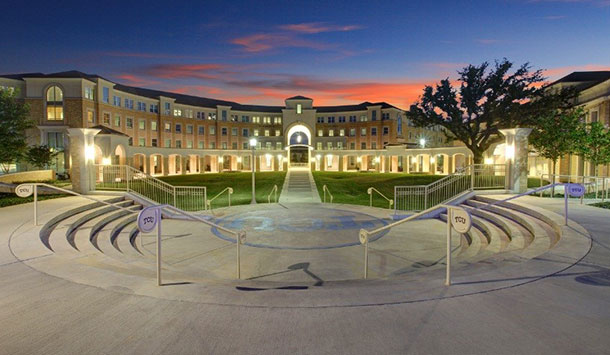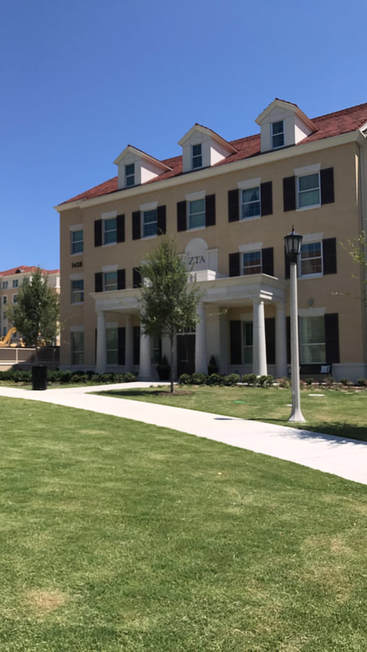TCU WORTH HILLS
Location: Texas Christian University, Fort Worth, Texas
Nickname: The Greek Village
Address: Bordered by Bellaire Drive N, Stadium Drive, and West Berry Street
Established: 1964/Renovation and expansion started in 2012
Provides: University owned and operated sorority and fraternity houses Sophomore student housing/residence halls
Dining Facilities
Parking Garage
Renovation
Status: Two Residence Halls completed 2012
Sorority Houses completed August 2017
Parking Garage completed August 2017
Fraternity Houses completion date August 2018
Renovation Cost: $40M
Location: Texas Christian University, Fort Worth, Texas
Nickname: The Greek Village
Address: Bordered by Bellaire Drive N, Stadium Drive, and West Berry Street
Established: 1964/Renovation and expansion started in 2012
Provides: University owned and operated sorority and fraternity houses Sophomore student housing/residence halls
Dining Facilities
Parking Garage
Renovation
Status: Two Residence Halls completed 2012
Sorority Houses completed August 2017
Parking Garage completed August 2017
Fraternity Houses completion date August 2018
Renovation Cost: $40M
Worth Hills (TCU) is a Greek Village (759,514 sq.ft.) within the private Christian-based, coeducational institution of higher learning Texas Christian University (TCU) in Fort Worth, Texas. The entrance to the village is through a three-story tall stone archway that serves as a recognition point for the Worth Hills student housing complex. The Greek Village includes three residence halls, 11 Greek chapter houses, a multi-purpose dining hall, and a parking garage.
The Worth Hills Village is designed in the Revival architecture style, drawing inspiration from historical styles of an earlier period. The buildings are constructed from a light yellow-colored brick with limestone accents and clay tile roofs. The color-scheme and materials of the Greek Village provide a cohesive look to the TCU campus. For the Greek chapter houses, the front facades vary so that each house looks unique with front porches and columns amid a park-like surrounding. (4)
The Worth Hills TCU Greek Village, the surrounding residence halls, and dining facility create a community that honors and embraces Greek culture and its ceremony for the TCU fraternity and sorority chapters. The open park area between the chapter houses has a Greek-style colonnade called the Divine Nine to represent the nine university fraternity and sorority chapters that do not have enough members to fill a chapter house. When it is completed in summer 2018, the Greek Village will have an ellipse, obelisk, and ovals to pay homage to its Greek heritage. (8)
Milestones in the History of TCU Worth Hills (from TCU Undergraduate Catalog) (10):
1963
Worth Hills Golf Course acquired for future expansion.
1964
Five residence halls and cafeteria completed on Worth Hills property.
2011
In November, construction of two residences halls In Worth Hills was announced as part of a multi-phase plan to create a new residential Worth Hills Village.
2012
Construction began on two new residence halls in Worth Hills.
2013
Two residence halls opened in the Worth Hills Development, Marion Hall and Pamela and Edward Clark Hall and a third was under construction.
2014
Marlene Moss Hays Hall opens in the Worth Hills residential development.
2015
Work begins on Greek Village in Worth Hills.
2017
Construction began in the summer on a re-envisioned Greek Village in Worth Hills that will support almost 800 students in 24 chapter houses.
1963
Worth Hills Golf Course acquired for future expansion.
1964
Five residence halls and cafeteria completed on Worth Hills property.
2011
In November, construction of two residences halls In Worth Hills was announced as part of a multi-phase plan to create a new residential Worth Hills Village.
2012
Construction began on two new residence halls in Worth Hills.
2013
Two residence halls opened in the Worth Hills Development, Marion Hall and Pamela and Edward Clark Hall and a third was under construction.
2014
Marlene Moss Hays Hall opens in the Worth Hills residential development.
2015
Work begins on Greek Village in Worth Hills.
2017
Construction began in the summer on a re-envisioned Greek Village in Worth Hills that will support almost 800 students in 24 chapter houses.
|
Contents [hide]
• 1History • 2Proposal • 2.1 Land Battle • 3The University's Building Needs • 3.1Short Term Needs • 3.2 Long Range Needs • 3.3Housing Most Urgent Need • 4TCU Plans for Worth Hills: • 4.1Expansion Opportunities • 4.2Fraternity & Sorority Houses • 5Worth Hills Residential Area (1964): • 5.1Tomlinson Hall • 5.2Martin-Moore Hall • 5.3Beckham-Shelburne Hall • 5.4Clark Hall • 6Worth Hills Residential Area (2018): • 6.1Phase I • 6.2Phase II • 7Additional Information •8References |
Image taken by Amanda Duncan on March, 20th, 2018
|
History:
Texas Christian University moved to Fort Worth, Texas from Waco, Texas in 1910. Around that same time period, the popularity of golf was on the rise in the Fort Worth area. The city of Fort Worth scheduled a meeting in February1917 to discuss the viability of public golf. The committee members approved the development of a nine-hole course just behind TCU's campus. The city purchased 106 acres of land for $39,000 just south and west of TCU to build the public golf course. Work began on the course four years later. In an article dated December 17, 1922, the Star-Telegram mentioned "that the first nine holes of the planned 18 would be open by Feb. 1, 1923." (3) For thirty-eight years, the golf course, locally known as "Goat Hills", operated on that site. It was called "Goat Hills" because of its tough course and rising and falling landscape. (3)
Proposal:
On 8 December 1960, TCU made a proposal to the Fort Worth city council offering to purchase land in the Southwest area of town and construct a golf course in exchange for the Worth Hills land.(3) TCU wanted to acquire the Worth Hills golf course land to construct physical education buildings, parking lots, ROTC drill fields and other facilities. TCU did not have the land available for the additional facilities.
TCU's proposal to buy the property set off a debate among the homeowners bordering the golf course with the primary opposition coming from the TCU- Westcliff Homeowner's League. Homeowners did not want their golf course view to be replaced with a view of dirt and cranes. TCU proposed to pay more than the fair market value for the land, agreed to limit the use the land to educational purposes, and agreed to delay taking possession.
Land Battle
In a city-wide election, TCU won the right to purchase Worth Hills. The city sold the golf course land to TCU in 1961. TCU paid $6,500 per acre, approximately $690,000 for the land.(3) With the funds, the city built a new municipal course near Benbrook Lake. Chancellor M.E. Sadler said, "Purchase of Worth Hills for TCU's expansion is the culmination of a dream held for many decades by the leaders of the city and the University. As our present campus became more and more crowded, the need for additional growing room became acute. Purchase of the course, which also will provide new recreational facilities for the citizens of Fort Worth, was the ideal situation."(3)
The University's Building Needs:
Short Term Needs
On March 1, 1961, TCU Chancellor M.E. Sadler outlined the short term university requirements that would result from the Worth Hills purchase. Sadler recognized an immediate need to build a Student Health Building; a Communications Building for Journalism, Radio-TV, and Advertising majors; one Women's Dormitory; one Men's Dormitory; one Dormitory for Married Students; and renovation or replacement of the Old Gym built in 1921. Additions to the Winton Scott Hall of Science was part of this expansion plan. (5)
Long Range Needs
The long range university requirements would be identified as enrollment increased. A research center, additional dormitories, a graduate school building and additional fine arts buildings were part of the long range vision. (5)
Housing Most Urgent Needs
The most urgent need for the university from the 1960’s to present day has been housing. The lack of undergraduate housing has been the limiting factor on increasing student enrollment. As interest increased in attending TCU, housing needs had to be addressed. These short term, long term, and most urgent needs pushed the construction on the
Worth Hills land to move at a quicker pace.(5)
TCU Plans for Worth Hills:
Construction on Worth Hills began almost immediately after the University acquired the land. The golf course was torn up and campus master planners began building the original Worth Hills Greek housing and other facilities. (5)
Expansion Opportunities
Development of the Worth Hills area of TCU facilitated the expansion of the university. Enrollment increased which resulted in an increase in faculty members, expanded fields of study, and continued investment in the buildings and infrastructure of the university. University sports programs flourished. Community involvement with the university increased.
Fraternity & Sorority Houses
The original plan for the Worth Hills property was additional dormitory style living facilities and not fraternity and sorority houses. There was no support for Greek housing and Greek organizations were not popular with university faculty, students, or community members. (5) TCU trustees permitted fraternities and sororities to organize in 1964 but determined that fraternity and sorority students would be required to live in campus-owned property not privately owned social houses.
Worth Hills Residential Area: 1964
Since 1964, the Worth Hills area of the campus has been called Greek Hill because most of the residence halls are home to TCU's social fraternities and sororities. Although Greek organizations were initially opposed by TCU students and faculty, today about half of TCU's undergraduates belong to nationally recognized chapters. The 1964 architecture of the Worth Hills social housing followed the classical style set for dorms in 1942. To express Greek pride, the sororities added a splash of color by mounting canopies over their entrance doors embossed with their Greek Chapter Letters.(5) There were four halls in this area in 1964: Tomlinson Hall, Martin-Moore Hall, Beckham Shelburne Hall, and Clark Hall.
Tomlinson Hall
Tomlinson Hall was "In honor of (a) great and good family,"(5) and named after T.E. Tomlinson who was a member of the Board of Trustees from 1907 to 1941. He was chairman when the decision was made to move TCU to Fort Worth. Tomlinson Hall was home to the Kappa Sigma, Sigma Chi, Phi Delta Theta, and Lambda Chi Alpha fraternities.
Martin-Moore Hall
The second fraternity dorm, situated west of Tomlinson Hall was named Martin-Moore Hall after two prominent figures. A TCU alumnus, Othol "Abe" Martin was the Frogs' head football coach from 1953-1966 also known as Honest Abe. Jerome A. Moore was part of the university as a student, teacher, and administrator. Martin-Moore Hall was home to Phi Kappa Sigma, Phi Gamma Delta, Delta Tau Delta, and Sigma Alpha Epsilon fraternities.
Beckham-Shelburne Hall
Beckham-Shelburne Hall was home to Pi Beta Phi, Chi Omega, Delta Gamma, and Kappa Alpha Theta sororities. Sadie Beckham and Elizabeth Shelburne had a combined service of more than forty years as deans of women at TCU.
Clark Hall
Freshman and sophomore men were assigned rooms in Clark. It was occupied by non-Greeks or those waiting for an opening in the fraternity dorms.
Worth Hills Residential Area: 2018
The original TCU fraternity and sorority houses were built on Worth Hills in 1964. Starting around 2010-2011, the TCU housing administration had to change existing residence hall study lounges into bedrooms and place three students in rooms designed for two students to accommodate increasing enrollment at the University. As expected, students, parents, and faculty members complained about the cramped accommodations. Additionally, the existing Greek housing on campus was outdated.
In 2011, the university began addressed the overcrowding concerns. The administration hired the architectural design team of KSQ Architects and HC Beck Builders to develop the plans for the new Worth Hills Village. With this plan, TCU added about 1,800 new beds, a new Greek Village, and additional student dining and parking all within what is now known as Worth Hills. (8) (9) TCU wanted to create the feeling of a home away from home for the students. The Greek Village facilities have modern kitchens and baths, WiFi and cable, and energy-efficient systems.
Phase I
Construction on Phase I of the two phases for the Worth Hills Residential Area was completed on July 30, 2017. Phase I of the TCU Greek Village included seven houses to accommodate 13 sororities and two fraternities. There are two different sororities in each house with a wall separating the groups. The first occupants were the 13 social sororities who are members of the Panhellenic Council: Alpha Chi Omega, Alpha Delta Pi, Alpha Omicron Pi, Chi Omega, Delta Delta Delta, Delta Gamma, Gamma Phi Beta, Kappa Alpha Theta, Kappa Kappa Gamma, Phi Mu, Pi Beta Phi, Sigma Kappa, and Zeta Tau Alpha.
Phase II
The second phase is currently being built. Eleven social fraternities which are members of the Inter-fraternity Council will be provided their own houses for the fall 2018. The current eleven social fraternities are Beta Theta Pi, Delta Tau Delta, Kappa Sigma, Lambda Chi Alpha, Phi Delta Theta, Phi Gamma Delta, Pi Kappa Phi (whose house is already finished), Sigma Alpha Epsilon, Sigma Chi, Sigma Nu, and Sigma Phi Epsilon.
Additional Facts(3):
- 1,800 new beds within the new Greek Village
- The additional student dining and parking all goes to the final cost
- Area: 759,514 sq.ft.
- Cost Per Square Foot: $52.66
- Feature In: 2012 Architectural Portfolio
- Sub Category: Campus Master Planning
- Final Cost: $40,000,000.
References:
,.1. “English Wikipedia.” Wikipedia, Wikimedia Foundation, 22 Mar. 2018, en.wikipedia.org/wiki/English_Wikipedia.
2. Fowler, and Madison Fowler. “Greek Village Construction Ahead of Schedule.” TCU 360, TCU 360, 7 Feb. 2017, www.tcu360.com/2017/02/greek-village-construction-ahead-of-schedule/.
3. “Glory of the Goat.” FWTX.com, www.fwtx.com/articles/glory-goat.
4. “School Designs.” Texas Christian University, Worth Hills Village - Project Details, schooldesigns.com/Project-Details.aspx?Project_ID=4449.
5. Swaim, Joan Hewatt. Walking TCU: a Historic Perspective. Texas Christian University Press, 1992.
6. “TCU Breaks Ground on Newest Phase of Worth Hills Residential Village.” RVi, www.rviplanning.com/2016/06/tcu-breaks- ground-on-newest-phase-of-worth-hills-residential-village/. (Image 1)
7. “Texas Christian University.” Wikipedia, Wikimedia Foundation, 17 Mar. 2018, en.wikipedia.org/wiki/Texas_Christian_University.
8.“Worth Hills Village.” KSQ Design, ksq.design/work/worth-hillsvillage-tcu.
9. www.physicalplant.tcu
10.. “Milestones in TCU History.” Texas Christian University - Milestones in TCU History, tcu.smartcatalogiq.com/en/current/UndergraduateCatalog/History-of-TCU/Milestones-in-TCU-History.
This page was last edited on 26 April 2018, at 8 pm.
2. Fowler, and Madison Fowler. “Greek Village Construction Ahead of Schedule.” TCU 360, TCU 360, 7 Feb. 2017, www.tcu360.com/2017/02/greek-village-construction-ahead-of-schedule/.
3. “Glory of the Goat.” FWTX.com, www.fwtx.com/articles/glory-goat.
4. “School Designs.” Texas Christian University, Worth Hills Village - Project Details, schooldesigns.com/Project-Details.aspx?Project_ID=4449.
5. Swaim, Joan Hewatt. Walking TCU: a Historic Perspective. Texas Christian University Press, 1992.
6. “TCU Breaks Ground on Newest Phase of Worth Hills Residential Village.” RVi, www.rviplanning.com/2016/06/tcu-breaks- ground-on-newest-phase-of-worth-hills-residential-village/. (Image 1)
7. “Texas Christian University.” Wikipedia, Wikimedia Foundation, 17 Mar. 2018, en.wikipedia.org/wiki/Texas_Christian_University.
8.“Worth Hills Village.” KSQ Design, ksq.design/work/worth-hillsvillage-tcu.
9. www.physicalplant.tcu
10.. “Milestones in TCU History.” Texas Christian University - Milestones in TCU History, tcu.smartcatalogiq.com/en/current/UndergraduateCatalog/History-of-TCU/Milestones-in-TCU-History.
This page was last edited on 26 April 2018, at 8 pm.



